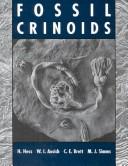| Listing 1 - 10 of 13 | << page >> |
Sort by
|

ISBN: 0521450241 Year: 1999 Publisher: Cambridge ; New York, NY : Cambridge University Press,
Abstract | Keywords | Export | Availability | Bookmark
 Loading...
Loading...Choose an application
- Reference Manager
- EndNote
- RefWorks (Direct export to RefWorks)
Book
ISBN: 0511626150 Year: 1999 Publisher: Cambridge : Cambridge University Press,
Abstract | Keywords | Export | Availability | Bookmark
 Loading...
Loading...Choose an application
- Reference Manager
- EndNote
- RefWorks (Direct export to RefWorks)
Crinoids have graced the oceans for more than 500 million years. Among the most attractive fossils, crinoids had a key role in the ecology of marine communities through much of the fossil record, and their remains are prominent rock forming constituents of many limestones. This is the first comprehensive volume which brings together their form and function, classification, evolutionary history, occurrence, preservation and ecology. The main part of the book is devoted to assemblages of intact fossil crinoids, which are described in their geological setting in 23 chapters ranging from the Ordovician to the Tertiary. The final chapter deals with living sea lilies and feather stars. The volume is exquisitely illustrated with abundant photographs and line drawings of crinoids from sites around the world. This authoritative account recreates a fascinating picture of fossil crinoids for palaeontologists, geologists, evolutionary and marine biologists, ecologists and amateur fossil collectors.
Book
Year: 1962 Publisher: Norman : University of Oklahoma,
Abstract | Keywords | Export | Availability | Bookmark
 Loading...
Loading...Choose an application
- Reference Manager
- EndNote
- RefWorks (Direct export to RefWorks)
Book
Year: 1953 Publisher: Washington : United States Department of the Interior, Geological Survey,
Abstract | Keywords | Export | Availability | Bookmark
 Loading...
Loading...Choose an application
- Reference Manager
- EndNote
- RefWorks (Direct export to RefWorks)
Book
Year: 1961 Publisher: Norman : University of Oklahoma,
Abstract | Keywords | Export | Availability | Bookmark
 Loading...
Loading...Choose an application
- Reference Manager
- EndNote
- RefWorks (Direct export to RefWorks)
Book
Year: 1909 Publisher: Washington : Government printing office,
Abstract | Keywords | Export | Availability | Bookmark
 Loading...
Loading...Choose an application
- Reference Manager
- EndNote
- RefWorks (Direct export to RefWorks)
Book
Year: 1963 Publisher: Norman, : University of Oklahoma,
Abstract | Keywords | Export | Availability | Bookmark
 Loading...
Loading...Choose an application
- Reference Manager
- EndNote
- RefWorks (Direct export to RefWorks)
Book
Year: 1974 Publisher: Ithaca, N.Y. : Paleontological Research Institution,
Abstract | Keywords | Export | Availability | Bookmark
 Loading...
Loading...Choose an application
- Reference Manager
- EndNote
- RefWorks (Direct export to RefWorks)
Crinoidea, Fossil. --- Paleontology --- Paleontology --- Paleontology
Book
ISBN: 0888543425 Year: 1988 Publisher: Toronto : Royal Ontario Museum,
Abstract | Keywords | Export | Availability | Bookmark
 Loading...
Loading...Choose an application
- Reference Manager
- EndNote
- RefWorks (Direct export to RefWorks)
Crinoidea, Fossil. --- Paleontology --- Paleontology --- Paleontology --- Échinodermes. --- Silurien. --- Paléontologie
Book
ISBN: 1108893457 1108810012 1108897878 1108898947 Year: 2022 Publisher: Cambridge : Cambridge University Press,
Abstract | Keywords | Export | Availability | Bookmark
 Loading...
Loading...Choose an application
- Reference Manager
- EndNote
- RefWorks (Direct export to RefWorks)
Fossil crinoids are exceptionally suited to deep-time studies of community paleoecology and niche partitioning. By merging ecomorphological trait and phylogenetic data, this Element summarizes niche occupation and community paleoecology of crinoids from the Bromide fauna of Oklahoma (Sandbian, Upper Ordovician). Patterns of community structure and niche evolution are evaluated over a ~5 million-year period through comparison with the Brechin Lagerstätte (Katian, Upper Ordovician). The authors establish filtration fan density, food size selectivity, and body size as major axes defining niche differentiation, and niche occupation is strongly controlled by phylogeny. Ecological strategies were relatively static over the study interval at high taxonomic scales, but niche differentiation and specialization increased in most subclades. Changes in disparity and species richness indicate the transition between the early-middle Paleozoic Crinoid Evolutionary Faunas was already underway by the Katian due to ecological drivers and was not triggered by the Late Ordovician mass extinction.
Crinoidea, Fossil --- Evolutionary paleoecology --- Evolutionary paleobiology --- Paleoecology --- Pelmatozoa, Fossil --- Crinoïdeus --- lemac
| Listing 1 - 10 of 13 | << page >> |
Sort by
|

 Search
Search Feedback
Feedback About
About Help
Help News
News